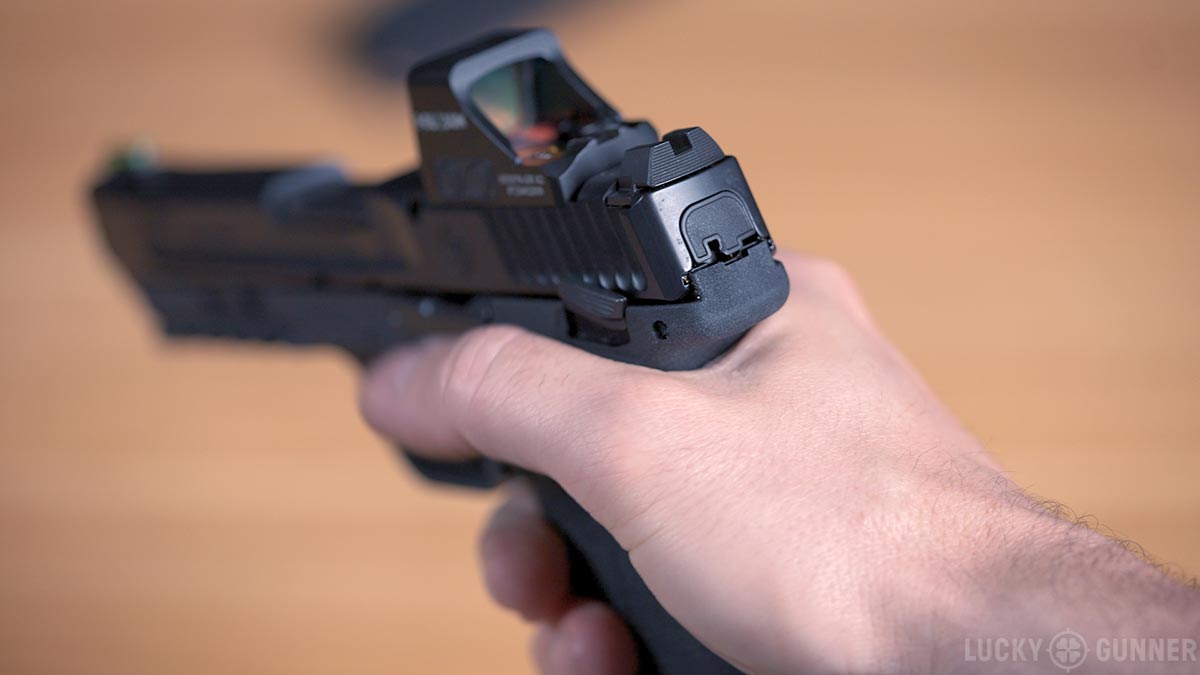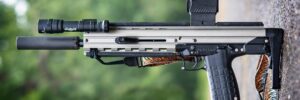We’re back with a deep dive into the new Smith & Wesson M&P 22 Magnum. Does this 30-round beast top KelTec’s own PMR30? Are we finally getting a semi-auto with rimfire recoil and centerfire reliability? We put over 1000 rounds through it to find out.
Details are in the video below, or keep scrolling to read the full transcript.
Hey everybody, I am Chris Baker from LuckyGunner.com and today I’m looking at the new Smith & Wesson M&P 22 Magnum.
It looks like the gun-buying public is finally growing weary of polymer striker-fired 9mms so gun companies are experimenting more with new cartridges like .30 Super Carry as well as some of the existing second-tier bench warmer cartridges like 5.7x28mm and .22 Magnum.
Earlier this year, Smith & Wesson brought us the M&P 5.7 with a new form factor that differs a bit from the other centerfire pistols in the M&P series. The M&P 22 Magnum is based on the 5.7 version. They have the same frame and slide dimensions, the same trigger, and both pistols use the Tempo Barrel System, which we’ll get to in a minute.
First, let’s look at the other basic specs and features. The M&P 22 Magnum is a single action only internal-hammer fired pistol with a manual ambidextrous thumb safety. The slide release is also ambidextrous and the mag release is reversible.
Fully loaded, it weighs 26.6 ounces with a 4.35-inch barrel. The drift adjustable iron sights come with a serrated black rear and a green fiber optic front.
The flat faced trigger has a nice, light takeup, breaking at just over 4.5 pounds. It’s not outstanding by single action standards, but it also lacks the mushiness you get in a lot of striker-fired triggers. By the way, the manual advises you to not dry fire the pistol like I just did. That’s unusual among modern pistols, even with rimfire models, so try to keep that in mind.
The slide is optics ready, compatible with the RMSc footprint. But there’s a catch. When you remove the polymer slide cover, you expose the firing pin channel.
You can direct-mount the optic without any adapter plate, but it’ll have to be an optic with a closed bottom. A lot of optics with this footprint have an open bottom, like this Sig RomeoZero. They rely on the slide itself to hold the battery in place, but obviously, that’s not going to work with this pistol. So you’ll need either some kind of bottom cover for that optic or a closed-bottom optic like this Holosun HS507K.
Because it’s a direct mount system, the optic sits nice and low, which is an ideal setup. With the Holosun, you can just barely use the iron sights through the optic window. I can see the top quarter of the front sight when it’s lined up with the rear.
Okay, here’s the really fun part. The magazine. 30-round capacity. Of course, Keltec was the first to give us a 30-round .22 Magnum with the PMR30 over a decade ago. In fact, for a long time, it was the only semi-auto .22 Magnum on the Market. A few others have come out in recent years. But until now, none of them had more than half the mag capacity of the PMR30.
Unfortunately, the PMR30 is also notorious for sub-par reliability and durability. Despite that, it has remained an exceptionally popular pistol, thanks in no small part to the generous mag capacity. So all Smith & Wesson would have to do to take the title away is make a reasonably priced 30-round .22 Magnum that works. Did they do it? Well, after running 1000 rounds through this particular M&P 22 Magnum, I’d have to say the answer is a big… maybe.
They got the reasonably-priced part right. The MSRP is $650 and right now it’s selling for around $600 at most places. That’s about $100 more than the KelTec, but it gets you a pistol that appears to be far superior in terms of materials and build quality. Aside from the polymer-body magazines, it feels like a serious pistol – it fits right in with the other members of the M&P family.
If I were going to be picky – and why wouldn’t I be? – the design has room for improvement in a few areas. The magazines are a little tricky to load. They’re nothing like the infuriating PMR30 mags, but it can be a bit tedious to get each round pushed all the way to the back of the magazine. I could see this being a challenge for inexperienced shooters.
The thumb safety is very narrow, almost like they were hoping you wouldn’t notice it’s there. This is not a low profile carry gun. There’s no reason the safety could not have more of an ergonomic shelf like many of the other pistols in the M&P series.
My last nitpick is the lack of a threaded barrel. You can’t attach a suppressor. That seems strange since the M&P 5.7 barrel is threaded. I’m not sure if this is a limitation of this pistol design with this cartridge, or if they just left it off to keep the cost down. The PMR30 is not compatible with a suppressor, even with a threaded barrel, so that could have been an easy way for Smith to one-up KelTec. It’s a little disappointing that they didn’t include that feature.
Since the release of Smith & Wesson’s folding 9mm carbine earlier this year, they’ve been catching a lot of grief online for copying KelTec. Maybe they deserve that, at least a little. That said, the M&P 22 Magnum is a completely unique design. The PMR30 uses a hybrid blowback/locked-breech system. The M&P 22 Magnum is gas-operated using the Smith & Wesson Tempo Barrel System.
The barrel here is in two pieces. What you can see right now is actually just the outer barrel sleeve. The barrel itself is inside. If we take it apart, you can see that there’s a gas port – this little hole in the top of the barrel near the muzzle end.
Some of the gas that’s forcing the bullet out of the barrel bleeds through that hole and pushes the barrel back. The slide and barrel travel together for the first quarter inch or so. Then the barrel stops and the slide keeps going to extract the case.
In theory, this system should be reliable with a wide variety of ammo types. But cycling has always been a tricky thing with any semi-auto using rimmed cartridges. And the round has a long way to travel between the magazine and the chamber. That’s a lot of opportunity for something to go wrong.
This M&P was very reliable with four of the five loads I ran through it. All five are included on Smith & Wesson’s list of recommended ammo for this pistol. The one that gave me trouble was the CCI Maxi-Mag 40-grain TMJ flat tip ammo. With that load, the gun would fail to feed, extract, or eject about 50% of the time. I tried it with and without the optic installed. Nothing I did would make it feed better.
The jacketed hollow point version of that load cycles just fine. It’s the same bullet weight and velocity as the TMJ load, so it seems like it would have to be the bullet profile that’s the problem. That doesn’t explain the failures to extract and eject, so I’m not sure what to make of it. I think this gun is going to be like most .22 LR pistols. You’re just going to have to try different loads to find the ones your particular pistol likes to feed.
In any case, the other four loads were almost 100% reliable. And I say “almost” because I did have quite a few failures to extract, but they were predictable. I did not have a single issue with these other loads until the gun got hot.
Heat build-up is a common issue with gas-operated pistol designs. On the M&P, that heat doesn’t reach the grip. It’s not going to burn you or anything. But the barrel and slide do get extremely hot and that, apparently, compromises reliability. There’s actually a warning about this in the manual. It says that after extended-rapid firing, some ammo might have difficulty extracting.
In my experience, the Hornady V-Max had the most trouble when the gun was hot. But none of the loads we had with us were immune to this issue. The manual doesn’t define “extended rapid firing.” I wasn’t doing repeated mag dumps, but I wasn’t taking my time either. We only have the two magazines that came with the gun, so we had to at least take a few minutes off to load them after every 60 rounds. Both times I ran into this issue, it was after firing roughly 250 rounds within a 30 minute time period. Ten to fifteen minutes of cooldown time was long enough to let it cycle another couple of magazines without any issues.
The interesting part is that the gun doesn’t get gradually less reliable as it heats up. It would be running 100 percent with no problems. Then I’d load a new magazine and the pistol would just say “no.” I’d start getting failures every other round. So if you have feeding issues right off the bat, make sure the gun is clean and lubed and that you have a high, firm grip. If it still won’t work, try a different type of ammo. If you only have problems when the gun is warm, just let it cool off for a few minutes and see if they go away.
But I can tell you that you’re not going to want to wait for it to cool off because shooting this pistol is just too much fun. There is next to no recoil. It’s like a very loud .22 LR. Low recoil with a dot is beyond easy mode shooting. It’s also extremely accurate.
I shot five round groups from the bench at 25 yards with those same five loads I mentioned earlier. The average group size hovered between one and two inches. That is fantastic for a stock handgun. It’s definitely better than any out-of-the box centerfire pistol I’ve tried.
With that kind of accuracy, the low recoil, and the massive magazine capacity, it’s an excellent plinking pistol, or something you could use to teach a new shooter. It would be great for pest control for property owners who don’t want to lug around a long gun all the time.
Of course, what everybody really wants to know is whether this would make a suitable self-defense pistol. It’s light enough to be carried all day, but it’s also quite large, especially the grip length. So in most cases, we would be looking at a potential home defense gun. For that role, I have trouble thinking of many reasons why a full size 9mm wouldn’t be a better option. You’d get the improved reliability of a rimless centerfire cartridge with roughly the same or slightly lower cost per round.
And while .22 Magnum seems to punch above its weight in terms of terminal ballistics, 9mm certainly has the more impressive resume as a defensive cartridge. The 30-round magazines might seem like an advantage, but to paraphrase Tom Givens, in a gunfight, you’re probably going to run out of time before you run out of ammo. So this would not be my first choice for a home defense gun. It would not even be in my top ten. At least not for the average person.
Where it might make sense is for shooters with medical issues that might prevent them from using a pistol with more recoil. I would not necessarily include small-statured shooters in that group. That’s because, while this grip is nice and thin, it’s also very long from front to back. The trigger reach might be an issue for people with extra small hands. But, let’s say your hands are big enough for this gun, but you’ve got arthritis or nerve damage or some other issue. The M&P 22 Magnum gives you an option that’s a step up from .22 LR but with similar felt recoil. The slide is not too difficult to rack, and if you mount an optic to it, you’ve got a little handle to help out with that.
The M&P 5.7, and other pistols chambered for that cartridge, also have very little recoil along with the benefit of centerfire reliability. The trade-off there is the increased cost of ammo. How does .22 Magnum compare to 5.7×28 ballistically? That’s something we’re working on right now. We’ve got a ballistic gel comparison of these two cartridges coming later this Fall, so keep an eye out for that.
In the meantime, if you’re considering the M&P 22 Magnum, remember it’s gonna crave some ammo. So be sure to get it from us with lightning fast shipping at LuckyGunner.com.














